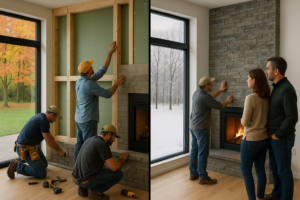Everything you need to plan, budget, and survive your renovation—from defining your “why” to navigating permits and keeping your sanity.
Remodeling your home is one of the most personal and financially significant projects you’ll ever undertake. The mere thought of it can be thrilling—and completely overwhelming. On one hand, there’s the dream: a chef-worthy kitchen, a spa-inspired bathroom, or simply a more livable layout that makes daily life smoother. On the other, there’s the reality: cost overruns, noisy construction, delays, and unpredictable contractors. If you’ve ever watched a home improvement show and wondered why your own renovation doesn’t wrap up in 30 minutes with a quirky montage, you’re not alone. The truth is, remodeling is rarely glamorous, often stressful, and always complex. But it can also be deeply rewarding.
This comprehensive guide isn’t about fantasy makeovers. It’s about giving you the tools, strategies, and knowledge to remodel smartly, avoid common pitfalls, and come out on the other side with a home that not only looks better but works better—for you and your lifestyle.
Why Remodel? Define Your “Why”
Every successful remodeling project starts with clarity of purpose. Before you start scouring Pinterest boards or visiting tile showrooms, take time to define your “why.” What’s driving your decision to remodel?
Ask yourself:
- Are you remodeling to improve functionality? Maybe your kitchen doesn’t work for your family’s cooking habits, or your bathroom layout wastes valuable space.
- Do you need more room? A growing family or multigenerational living may require reconfiguring or expanding.
- Are you simply tired of your home’s outdated look and want a modern refresh?
- Are you preparing to sell and hoping to increase your property value?
Understanding your motivations will help you make decisions that align with your long-term goals. It prevents you from falling for trends that don’t serve your needs and keeps you focused when tough budget choices arise. It also gives you a benchmark to evaluate trade-offs—do you splurge on heated floors if your main goal is ROI?
For example, if you’re remodeling to sell, your design choices may skew neutral and broadly appealing. If you’re remodeling for your forever home, you might lean more personal and custom. Let your “why” guide every “what.”
Make a written list of your remodeling goals, ranked by importance. Label each item as a “need,” “want,” or “nice-to-have.” This matrix becomes your north star during the budgeting and decision-making phases, helping you stay focused and reducing post-remodel regrets.
Budgeting: Planning Smart and Building a Safety Net
Money is often the most stressful part of a renovation—and the most common reason projects spiral out of control. It’s critical to establish a realistic, well-researched budget and build in a buffer for surprises.
Start with a comprehensive list of expected costs:
- Materials (flooring, tile, fixtures, cabinetry)
- Labor (contractor fees, specialized trades)
- Permits and inspections
- Temporary accommodations or storage if needed
- Design or architectural fees
- Tool and equipment rentals (often overlooked)
Next, consider location and market variables. Remodeling a bathroom in Des Moines isn’t going to cost the same as remodeling one in Los Angeles. Regional labor rates, permit costs, and even availability of materials can impact your bottom line.
Use online estimators, speak with local contractors, and consult your city’s permit office to gauge average pricing in your area. Always verify pricing on big-ticket items like cabinetry and appliances, which can account for 40–60% of your budget.
One major mistake is forgetting the contingency fund. Experts recommend setting aside 10–20% of your total budget for unexpected issues. If your total planned spend is $50,000, you should budget at least $5,000–$10,000 more for unforeseen expenses. Mold behind drywall, structural fixes, or outdated wiring can derail plans—and finances—fast.
Create a detailed spreadsheet and track costs continuously throughout the remodel. Break down each line item and update it regularly—this running tally will keep you on track and accountable.
Why Remodeling Budgets Go Off the Rails
Even the most carefully planned remodel can run over budget. According to a 2023 Houzz study, 53 percent of homeowners who set a budget ended up exceeding it. Why? The reasons are often avoidable with proactive planning:
- Hidden issues: You won’t know about termite damage or rotted subflooring until you open the walls. Budgeting for these kinds of surprises is key.
- Scope creep: It’s tempting to add “just one more thing” once the project is underway. Suddenly, replacing a vanity turns into a full tile job, new fixtures, and upgraded lighting.
- Price volatility: Lumber, steel, and other construction materials can spike unexpectedly. This was especially true during and after the COVID-19 pandemic when supply chains were disrupted.
To reduce risk:
- Lock in material prices when possible
- Stick to your original scope
- Make all key decisions before the project starts
- Use a written change order system if you must make modifications
Track your spending weekly. Weekly check-ins reveal small overages before they spiral. If possible, use project management software or apps to track timelines, invoices, and materials.
Measuring ROI: Not All Upgrades Are Created Equal
If you’re remodeling with resale in mind, it’s smart to focus on projects that add measurable value to your home. Kitchens and bathrooms tend to offer the best returns, with average ROI ranging from 60 to 80 percent.
Projects with strong ROI:
- Minor kitchen remodel: cosmetic upgrades like painting cabinets, new counters, and modern appliances
- Bathroom refresh: new tile, fixtures, and improved lighting
- Curb appeal: replacing the front door or updating landscaping
- Energy efficiency upgrades: new windows, insulation, or HVAC systems
Projects with weaker ROI:
- Luxury or niche upgrades: home theaters, saunas, or wine cellars appeal to a narrow audience
- High-maintenance additions: pools or elaborate landscaping may deter some buyers
Still, ROI isn’t just financial. Improving your quality of life—less clutter, better storage, more functional space—is valuable too. If your remodel makes your home work better for your family, that’s a return that goes beyond the bottom line.
Also consider neighborhood comps. Overimproving your home can price it out of your local market. Research recent sales nearby to understand what buyers expect at your home’s price point.
How Remodeling Impacts Daily Life—and How to Manage It
The biggest surprise for many first-time renovators? Just how disruptive remodeling can be. Your routines will change. Your home may not feel like your own for weeks—or months.
Challenges to expect:
- Constant noise and dust
- Limited access to essential areas (kitchen, bathroom)
- Tools and materials cluttering common spaces
- Early morning starts and contractor foot traffic
Mitigation strategies:
- Set up a temporary kitchen with essentials like a toaster oven, hot plate, and mini fridge
- Establish “clean zones” where work isn’t allowed to preserve some sense of order
- Plan meals, laundry, and bathing schedules around construction access
- Communicate with your contractor about daily start/end times
Families with young children or pets should plan extra carefully. Dogs may need to stay with a friend or doggy daycare during loud demo days. Toddlers can’t be around exposed nails and open paint cans.
Also consider:
- Renting a portable toilet for exterior work to reduce mess indoors
- Scheduling a weekly deep clean of construction areas
Picking the Right Features: The “Good-Better-Best” Method
One of the hardest parts of remodeling is choosing what to prioritize. The “good-better-best” model offers a framework for smart choices:
- Good: Budget-friendly basics that offer solid performance
- Better: Mid-range options balancing cost and quality
- Best: Premium materials or features for aesthetics and longevity
This approach lets you splurge where it counts—like a better oven for the home cook or radiant heat floors for a master bath—while saving elsewhere. Instead of blowing your budget on high-end everything, you can mix and match to get the best outcome.
For example:
- Go with “good” flooring to afford “better” lighting
- Skip marble counters for durable quartz and spend on cabinet organizers
Also critical: compare multiple contractor bids. Prices can vary dramatically for the same job, and a third bid might expose red flags you missed.
Avoid these common traps:
- Changing designs mid-project
- Failing to account for taxes, delivery, and install fees
- Ignoring resale value when choosing ultra-personal design features
DIY vs. Hiring Pros: Your Remodeling Game Plan
Once your vision is clear, the next question is execution. Should you do it yourself, hire a handyman, or bring in a general contractor?
DIY
Pros:
- Cost savings
- Full creative control
Cons:
- Time-intensive
- Risk of costly mistakes
- May void warranties on some materials or products
DIY works best for simple updates like painting, installing fixtures, or demo. Complex work (like plumbing or structural changes) should be left to the pros. Be honest about your skills and the time you can commit.
Handyman
Ideal for small repairs, minor installs, or odd jobs. They’re more affordable than contractors but may lack capacity for large-scale work. Always verify licensing and insurance.
General Contractor
Best for major remodels involving multiple trades (electrical, plumbing, structural). They’ll manage permits, subcontractors, and timelines. Expect to pay more—but save in peace of mind. A good GC is worth their weight in gold.
Vet your contractor thoroughly:
- Check references
- Verify license and insurance
- Review contract terms carefully
Permits, HOAs, and Legal Red Tape
Ignoring paperwork is a rookie mistake. Most remodels require permits to ensure code compliance and safety.
- Permit costs range from $50 to $1,000+, depending on project scope and location
- You may need multiple inspections throughout the job
- Unpermitted work can void insurance or cause issues at resale
If you live in a community with a homeowners association (HOA), get approval before starting. HOAs often have design guidelines, noise restrictions, or specific materials you’re required to use. Delays here can cost you weeks—or fines.
Your contractor should help manage permits and inspection scheduling, but always verify what’s covered in your agreement. Keep copies of all approvals and inspection records for future reference or resale.
Final Thoughts: Remodel with Confidence
A remodel can dramatically improve your home’s value, function, and appeal—but only if done with thoughtful planning and clear priorities. Define your motivation. Build a realistic budget. Anticipate disruption. Hire wisely. And don’t skip the red tape.
Approach the process with the right mindset and resources, and you’ll be far more likely to end up with a space that enhances your life rather than complicates it.








